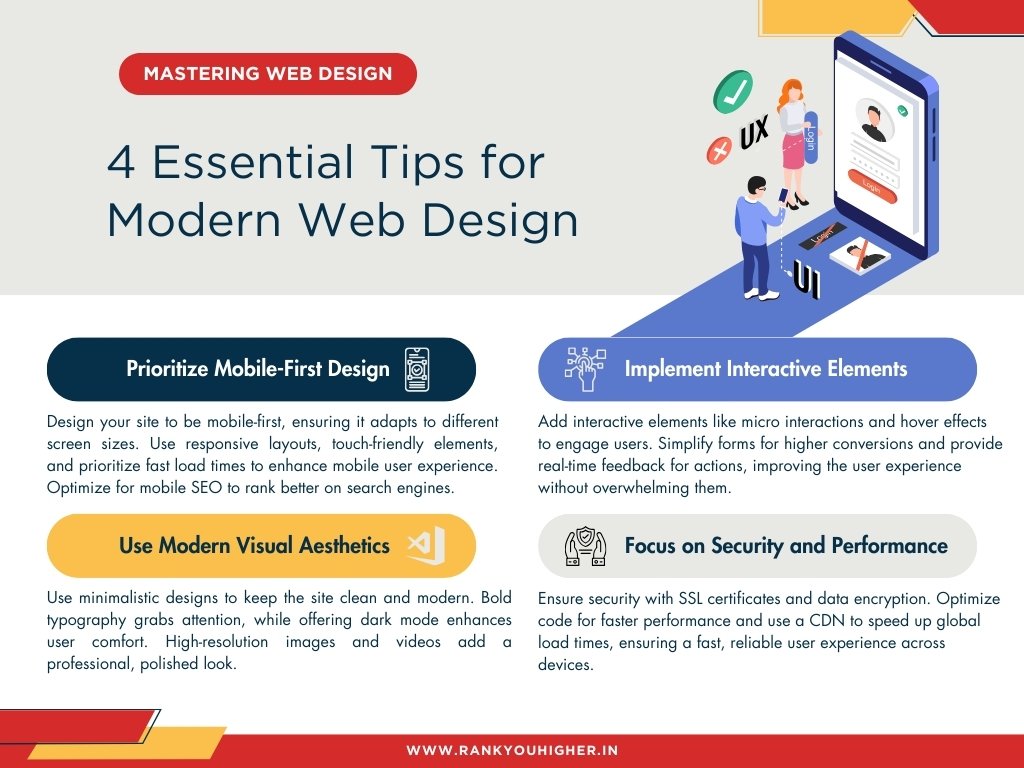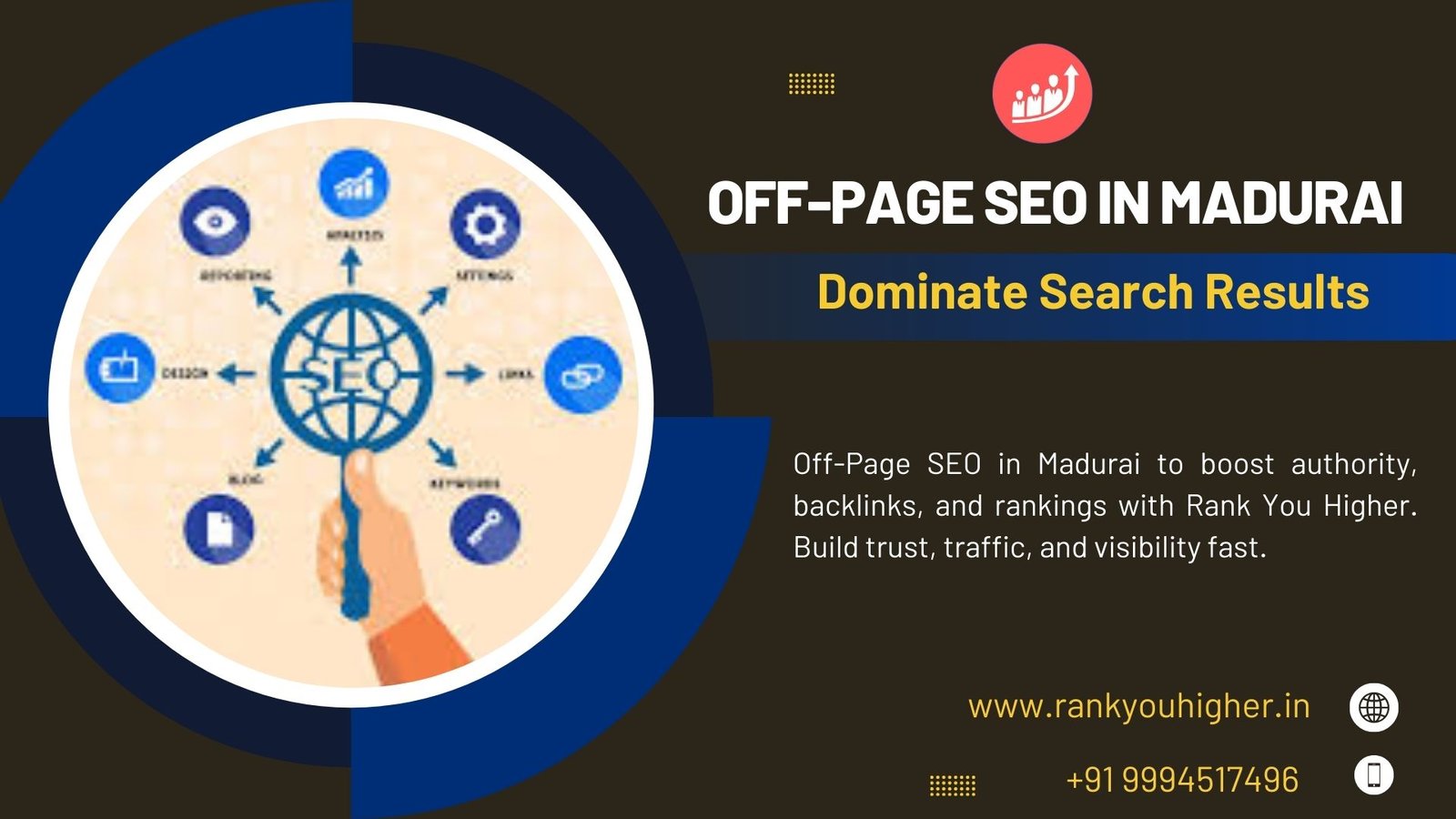4 Essential Tips for Modern Web Design: Boost Performance, Aesthetics, and Security
Creating an effective and visually appealing website is more important than ever in today’s digital age. A website that’s not only aesthetically pleasing but also secure, fast, and user-friendly is vital to success. If you want your website to stand out, follow these 4 essential tips for modern web design with Rank You Higher to ensure it meets current trends and performance standards.
1. Prioritize Mobile-First Design for a Seamless Experience
With the rise of smartphones, it’s crucial that your website caters primarily to mobile users. Designing a mobile-first website means focusing on making your site accessible and responsive on smaller screens before scaling it up for desktops. This approach ensures that mobile visitors have an equally satisfying experience as desktop users.
Responsive Layouts: A mobile-first layout adjusts automatically to fit any screen size, whether it’s a smartphone, tablet, or desktop. This responsiveness makes navigation easier for all users.
Touch-Friendly Elements: Optimize buttons, links, and other interactive elements to be easily tappable on touchscreens. Mobile users appreciate when navigation is simple and intuitive.
Fast Load Times: Ensure your site loads quickly on mobile devices by compressing images and minimizing heavy code. A fast-loading site reduces bounce rates and keeps users engaged.
Mobile SEO: Search engines like Google prioritize mobile-friendly websites in search results. By optimizing for mobile SEO, your site has a better chance of ranking higher in mobile searches, bringing in more visitors.
Prioritizing mobile-first design is a smart move, considering that mobile traffic continues to grow. You want to make sure your users enjoy seamless access to your content, no matter what device they are using.
2. Implement Interactive Elements to Engage Users
To keep users engaged, modern websites should include interactive features that make browsing fun and intuitive. Simple interactions can make your site feel more dynamic without overwhelming users.
Micro interactions: These are subtle animations or changes that occur when users interact with your site, such as clicking a button or hovering over an image. They provide feedback and enhance user engagement.
Interactive Forms: Forms are a key part of many websites. By simplifying the design and adding interactive elements, you make them easier and quicker to fill out, increasing your conversion rates.
Hover Effects: Adding hover effects gives users instant feedback when they hover over buttons, links, or images. This feature improves the user interface by making it more engaging and informative.
Real-Time Feedback: Real-time feedback, such as confirming a successful form submission or indicating errors in real-time, helps users feel more confident navigating your website.
Interactive elements bring your site to life. They make users feel more connected to the content, enhancing their overall experience and increasing the likelihood of conversions.
3. Use Modern Visual Aesthetics to Create a Clean, Trendy Look
A visually appealing website that’s easy to navigate is key to keeping visitors engaged. The design trends of modern web design lean towards simplicity and clarity, giving users an intuitive experience.
Minimalistic Design: Less is more. A clean, clutter-free design makes it easier for users to find the information they need. By stripping away unnecessary elements, you allow the most important content to shine.
Bold Typography: Using bold fonts can highlight key messages or sections of your website. It’s an easy way to grab users’ attention and direct them toward the most important information.
Dark Mode: Offering users a dark mode option has become a trendy feature in modern web design. Not only does it give your website a sleek, modern look, but it also reduces eye strain for users, especially when browsing at night.
High-Resolution Media: High-quality images and videos can elevate your website’s professionalism. Avoid pixelated or blurry visuals as they can detract from the user experience and make your website appear less credible.
By adopting modern aesthetics, you give your website a contemporary, professional feel that keeps users engaged and makes your brand look polished and trustworthy.
4. Focus on Security and Performance for Better User Trust and Speed
Security and performance are non-negotiable aspects of any modern web design. With rising cyber threats, users are more cautious than ever when browsing the web. On top of that, slow load times can drive visitors away.
SSL Certificates: Secure your website with an SSL certificate to ensure that all data exchanged between users and the site is encrypted. This builds trust with your visitors, as they know their information is safe.
Optimized Code: Using modern coding practices ensures that your website loads quickly and runs smoothly. Clean, efficient code reduces errors and improves overall performance.
Data Encryption: Protect user data, especially if your website handles sensitive information like personal details or payment information. Encryption keeps data secure and prevents breaches.
CDN Integration: Using a Content Delivery Network (CDN) ensures your website loads quickly across the globe by serving content from servers that are geographically closer to the user. Faster load times mean better user experience, especially for global audiences.
Focusing on security and performance gives users peace of mind when interacting with your website. A fast, secure site helps build trust and keeps visitors returning for more.
Conclusion
By implementing these 4 essential tips for modern web design, you can create a website that not only looks great but also functions efficiently. Prioritizing mobile-first design, adding interactive elements, utilizing modern aesthetics, and ensuring top-level security and performance will keep your users engaged and build trust in your brand. As the digital world evolves, following these key strategies will help your website stand out and succeed.





